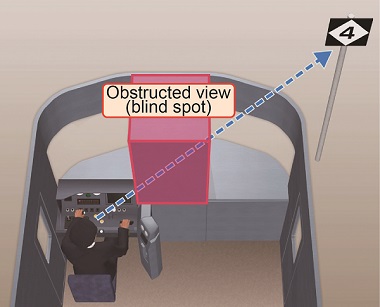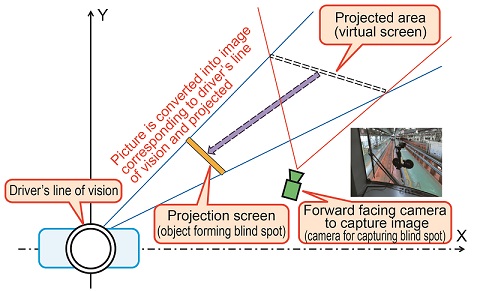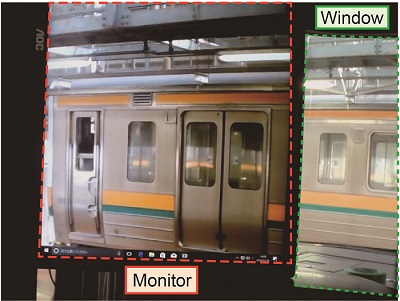9. Driver visual recognition support method using image processing
The presence of large members in the driver’s cab or in gangways can narrow a driver’s field of vision (Fig. 1). In order to reduce these blind spots, new image processing technology has been employed in a method to project the external obstructed viewpoint onto a display, such as a monitor, so that the driver can see through the blind spot as naturally as possible. Generally, it is not possible to install a camera on the back of the member blocking the extension of the line of vision of the driver. Consequently, as shown in Fig. 2, a forward facing camera is used, positioned at a different angle to capture the obstructed view. A virtual screen is inserted into the camera image to reflect the projected view. A method was then developed that makes it possible to project the image on the virtual screen onto a display: the 3-D coordinates in the four corners of the virtual screen are converted to 2-D coordinates and a projection conversion program was built and used to project the coordinates of the four corners onto the projection display.
A prototype set of equipment was built where the blind spot image, processed in about 10ms, was projected onto a monitor located to the side of the driver’s seat. This in-situ test confirmed that the driver’s natural line of vision could be reproduced (Fig. 3). Applying this equipment as a visual support to the driver can eliminate blind spots that prevent the driver from seeing some stop-position signs, etc. which alleviates driver load.
Other Contents
- 1. Earthquake damage simulator for railways with self-correcting function
- 2. Practical application of early earthquake warning method using ocean bottom seismometer data
- 3. Countermeasures to prevent subsidence of abutment backfill and track buckling during earthquakes
- 4. Ground surface layer response evaluation method for very large earthquakes
- 5. Anti-seismic reinforcement method for suspended-ceilings with small cavities at stations
- 6. Algorithm to estimate strong wind locations due to such as gusts.
- 7. Flowchart to determine possibility of reusing bridge following scouring damage
- 8. Increase in accuracy of bogie hunting stability evaluation
- 9. Driver visual recognition support method using image processing
- 10. Health monitoring of very large structures using long-range U-Doppler
- 11. Influence of pinion shaft bearing endplay (axial clearance) on its seizure initiation
- 1. Earthquake damage simulator for railways with self-correcting function
- 2. Practical application of early earthquake warning method using ocean bottom seismometer data
- 3. Countermeasures to prevent subsidence of abutment backfill and track buckling during earthquakes
- 4. Ground surface layer response evaluation method for very large earthquakes
- 5. Anti-seismic reinforcement method for suspended-ceilings with small cavities at stations
- 6. Algorithm to estimate strong wind locations due to such as gusts.
- 7. Flowchart to determine possibility of reusing bridge following scouring damage
- 8. Increase in accuracy of bogie hunting stability evaluation
- 9. Driver visual recognition support method using image processing
- 10. Health monitoring of very large structures using long-range U-Doppler
- 11. Influence of pinion shaft bearing endplay (axial clearance) on its seizure initiation



